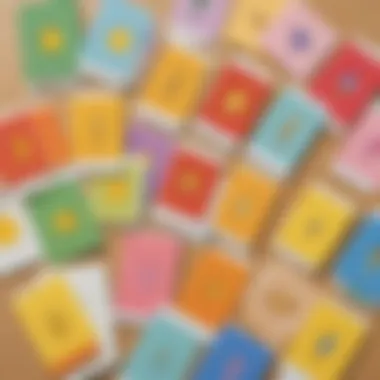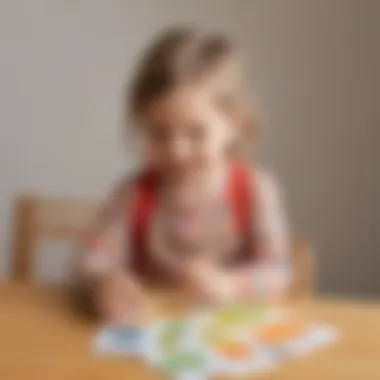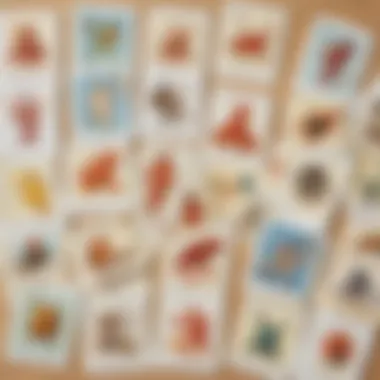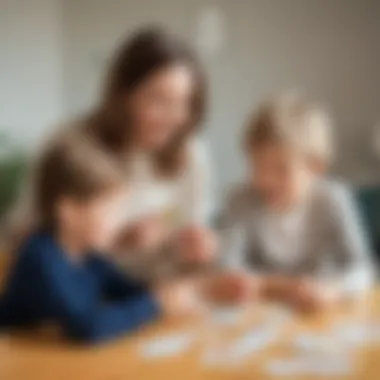Using Flash Cards Effectively with Five-Year-Olds


Intro
Flash cards have become a staple in the world of early childhood education. For five-year-olds, the cognitive whirlwind they experience is astonishing. At this age, kids are not just learning to recognize letters or numbers; they are exploring the world, developing critical thinking skills, and laying the groundwork for lifelong learning. Flash cards can be an invaluable asset in this journey.
Used effectively, they provide a dynamic, engaging way to reinforce concepts and foster retention. Adults often wonder how to implement them successfully, and that's where a comprehensive guide shines through. By understanding the advantages, various types of flash cards, and creative ways to use them, parents and teachers can create powerful educational experiences.
In this guide, we will explore a treasure trove of fun activities, educational games, and practical parenting tips to enrich the learning environment of young children. Whether it's indoor activities that spark their imagination, outdoor adventures that get them moving, or arts and crafts that inspire creativity, there is a wealth of opportunities for enriching play. Let’s dive in.
Preface to Flash Cards for Early Education
In the realm of early education, utilizing tools that kindle a child's innate curiosity is crucial. One such tool that stands out is flash cards. These compact learning aids can serve multiple purposes and, when used effectively, can make the process of learning both enjoyable and productive for children. They are simple in design yet powerful in application, making them a staple in the parents' and educators' toolkit.
Understanding Child Development at Age Five
By the time a child reaches five years old, several key developments in cognitive, social, and emotional realms have occurred. At this age, children tend to exhibit notable growth in linguistic skills. They can speak in full sentences and understand more complex ideas, which lays the groundwork for effective communication. Furthermore, their ability to focus for short periods begins to emerge, allowing for more structured learning experiences.
In this stage, kids are eager to explore the world around them, often asking questions and seeking to understand how things work. This is where flash cards come into play. They help harness this developmental drive, presenting information in bite-sized pieces, which aligns perfectly with shorter attention spans. Flash cards can transform abstract concepts, like letters and numbers, into tangible learning experiences. Using imagery alongside vocabulary can boost comprehension and retention, as children engage with the cards and collaborate with their caregivers to decode each lesson.
"Learning through play is vital for children at this age, and flash cards can easily blend fun with education."
The Role of Flash Cards in Learning
Flash cards act like bridge builders in the learning landscape for five-year-olds. They facilitate a hands-on approach, allowing children to engage actively with educational material. Unlike passive reading or rote memorization, flash cards inspire interaction through play. A child may flip a card, see a colorful image, and suddenly, the memory of what that letter or number means becomes clearer.
What’s more, this tool fosters not only cognitive development but also boosts confidence. As children notice their own progress while mastering new words or numbers, it reinforces a positive self-image. This self-assurance encourages them to take on more significant challenges in their educational journey.
In summary, the integration of flash cards in early education prompts vibrant discussions and active participation. They fit seamlessly into the exploratory nature of a five-year-old, leading to a richer learning experience while reinforcing fundamental concepts. With the right approach and creative designs, flash cards can open doors to new knowledge and joy in learning.
Types of Flash Cards for Five-Year-Olds
When it comes to teaching five-year-olds, the type of flash cards utilized can greatly influence the learning experience. Each category of flash card serves a unique purpose and taps into different aspects of a child’s cognitive development. From grasping basic language skills to building numerical awareness, each type benefits children's education in a specific way. By selecting the right cards, parents and educators can pave the way for effective learning that keeps youngsters intrigued and engaged.
Alphabet Flash Cards
Alphabet flash cards are the building blocks of early literacy. These cards introduce children to the letters of the alphabet, which form the foundation of reading and writing. One might wonder why knowing the alphabet is vital at this stage. Well, understanding letters helps five-year-olds recognize their shapes and sounds, ultimately making it easier for them to form words.
Here are some key perks of using alphabet flash cards:
- Letter Recognition: Kids become familiar with each letter, making it easier to differentiate them.
- Phonemic Awareness: Mapping sounds to letters is crucial, and flash cards can aid in this process.
- Creative Pairing: Combine the cards with images for each letter; for instance, having an apple card with the letter A enhances association.
Using a mix of uppercase and lowercase letters can further bolster understanding, enabling children to navigate different contexts, such as reading books or writing their names.
Number Flash Cards
Just like learning letters, grasping numbers is essential for developing mathematical skills. Number flash cards help kids understand quantity, recognize numbers, and grasp basic arithmetic. At age five, kids are usually curious about counting and adding. What's even more interesting here is that number flash cards aren’t just about memorization—they’re practically a springboard for exploring mathematics in a fun way.
The benefits of number flash cards include:
- Numerical Recognition: Children learn to identify numbers visually, which is crucial for future math skills.
- Count and Calculate: Pair them with small objects like blocks or snacks that reinforce counting and simple addition or subtraction.
- Game Time: Turn learning into a game by having kids race against the clock to flash the correct number when called out.
With these cards in hand, children can build a strong numerical foundation they'll rely on throughout their educational journey.
Sight Word Flash Cards


Sight words are those common words that kind of pop up all over the place in reading materials. Teaching sight words to children through flash cards is an effective strategy because these words often defy standard phonetic rules. If kids can recognize them quickly, it boosts their reading fluency significantly.
A few reasons why sight word flash cards are beneficial include:
- Immediate Recognition: Kids learn to identify these words without having to sound them out, which makes reading smoother.
- Increases Confidence: Mastering sight words can give kids a sense of accomplishment as they see their reading progress.
- Diverse Contextual Learning: Show sight words in multiple sentences or stories to help children understand how these words fit into different contexts.
With practice, sight words gradually become second nature, guiding children as they dive into more complex reading.
Picture Flash Cards
Picture flash cards offer a visual cue that engages multiple senses in the learning process. These cards depict objects, animals, and other concepts, allowing kids to associate words with images. This pairing aids retention more than just plain text might.
Utilizing picture flash cards can be advantageous for several reasons:
- Visual Learning: Pictures can cement concepts better, especially for visual learners.
- Cognitive Association: Pairing words and images helps in associative learning, making it easier for kids to recall information.
- Engagement Factor: A colorful, interactive card can spark interest; just seeing them can make children excited to learn.
Through the use of such cards, children develop not just vocabulary but also creativity, as they imagine and describe the images on the cards.
Quotes to Remember: "The right kind of flash card not only educates a child but also opens their mind to possibilities."
In summary, understanding the types of flash cards available for five-year-olds is essential in fostering an enriching learning atmosphere. Each type offers unique advantages that cater to the varied learning styles of children. By being intentional in choosing the right flash cards, educators and parents alike can help cultivate a love for learning that stays with children as they continue their educational paths.
Benefits of Using Flash Cards
Flash cards can be a game changer in a young child's learning experience. The advantages they offer go far beyond just simple memorization. In this section, we delve into the key benefits of using flash cards, highlighting how they can enhance a child's cognitive development and foster a love for learning.
Enhanced Memory Retention
One of the fundamental aspects of child development at five years old is their ability to absorb new information. Flash cards serve as a useful tool in this process. The repetitive nature of flash card use helps to cement knowledge in a child’s memory. For instance, regularly reviewing a set of alphabet flash cards can make recognizing letters second nature.
Moreover, employing visual cues—such as images or colors—can significantly boost memory retention. This multisensory approach creates strong mental associations, which are more likely to stick in a child's mind. As the saying goes, "A picture is worth a thousand words." Visual representation paired with the written word can strengthen connections in a child's developing brain, making it easier for them to recall information when needed.
Encouragement of Active Participation
Flash cards not only aid memory but also encourage kids to engage actively in their learning. Through interactive games that involve flash cards, children can take part actively rather than passively absorbing information. This engagement is crucial; it makes the learning experience lively and meaningful.
For example, a parent can create a game where the child races to identify pictures or words on flash cards in response to prompts. This type of activity transforms learning into a fun and exciting experience. The concept of learning through play is essential for this age group. Active participation not only maintains a child’s interest but also boosts comprehension and retention of the material.
Development of Core Vocabulary
An essential aspect of early education is vocabulary acquisition. Flash cards specifically designed for sight words or common phrases enhance a child’s vocabulary more effectively than traditional reading methods alone. The simple act of showing a child a flash card with a word along with its corresponding image can help them grasp the meaning of words more intuitively.
Incorporating words in context is vital. For instance, showing a card with the word "dog" alongside an image of a dog encourages children to make associations between the word and its meaning. Furthermore, introducing these cards during everyday activities—like during a walk or playtime—can reinforce learning. This hands-on approach helps weave vocabulary into their everyday lives.
Essential Tip: Use flash cards regularly, but balance them with other learning methods to maintain an engaging educational environment.
The benefits of using flash cards are multifaceted. They support memory retention, promote active learning, and aid vocabulary development. These tools, when used creatively, can ignite curiosity and foster a lifelong love for learning in children.
Potential Drawbacks and Considerations
While flash cards can be a powerful educational tool for five-year-olds, their use is not without potential drawbacks. It's essential to weigh the pros and cons to maximize learning while avoiding unintended consequences. This section delves into the considerations surrounding flash card usage, specifically focusing on the risk of over-reliance and the distinction between mere flashing of cards and engaging interactions.
Over-reliance on Flash Cards
One of the most significant concerns with using flash cards is the risk of children becoming overly reliant on them. When flash cards become the primary method of learning, other valuable skills can fall by the wayside.


For instance, a child might memorize a term associated with a card without grasping its context or usage. This can lead to a situation where they can recognize words on cards but struggle to apply them in real-world conversations.
Additionally, overuse of flash cards can narrow the scope of learning. Instead of exploring concepts through diverse methods such as storytelling, hands-on projects, or discussions, children might be stuck in a repetitive pattern. It's crucial for educators and parents to balance flash card use with other teaching approaches.
- Provide varied learning experiences to enhance understanding.
- Discuss concepts with children in daily situations.
- Encourage expressive skills through storytelling, singing, or drawing.
By diversifying learning methods, children can develop a more holistic understanding of the material rather than merely rote memorization.
Flashing vs. Engaging
The second concern revolves around the difference between quickly flashing cards in a parade of visual stimuli versus engaging a child in thoughtful, interactive learning. Flashing cards might catch a child's immediate attention, but it lacks depth. Rapidly showing a series of cards can cause confusion or dull interest, making the learning feel like a chore rather than a joyful discovery.
Engaging methods, however, transform the learning experience into a playful exploration. Instead of just showing a card, asking questions related to it helps to stimulate critical thinking.
For example, instead of simply showing a picture of an apple and saying its name, consider asking:
- "Can you think of something that grows on trees?"
- "What color is an apple?"
- "Have you eaten an apple? What does it taste like?"
This not only enhances comprehension but also keeps children curious and invested in their learning. We should aim for a rich exchange of ideas, allowing vocals and expressions to mesh with visuals, creating an environment filled with learning excitement.
"The goal is to foster a love for learning, not just a love for flash card memorization. The journey matters as much as the steps taken along the way."
Creating Effective Flash Cards
Creating effective flash cards is crucial in providing a solid learning foundation for five-year-olds. This age is a period of significant cognitive development, where children are eager to explore and absorb new information. Having well-designed flash cards can be the difference between engagement and disinterest in learning. Each aspect of the flash card's content and design influences a child's willingness to participate in the educational process, making it essential to focus on topics that resonate with their curious minds.
Selecting Appropriate Content
When choosing content for flash cards, consider the developmental stage of the child. At five years old, children are typically grasping the basics of language, numbers, and shapes. Therefore, focus on simple yet impactful topics. For instance:
- Letters and Sounds: Choose letters that create familiar words.
- Basic Numbers: Use numbers that relate to everyday contexts, like counting fruits or toys.
- Colors and Shapes: Familiar objects like apples or balls can bring these concepts to life.
It's important to ensure that the material is age-appropriate and reflects the child's interests. Use examples from their daily life that they find fascinating or amusing. This can foster a sense of ownership and relevance in their learning journey.
Design and Visual Presentation
Visual appeal is a significant factor in capturing a child's attention. The design of flash cards should be vibrant yet simple, showcasing colors that stimulate rather than overwhelm. Each card should include:
- Bold Text: Clear, easy-to-read fonts help in recognizing words.
- Illustrations: Pictures that represent the concept make learning memorable. For instance, a picture of a cat next to the word "cat" helps connect imagery with language.
- Consistent Style: A uniform design across cards creates a cohesive learning experience and helps children associate concepts more easily.
It's key to strike a balance between creativity and clarity. Overly intricate designs can muddle the learning process instead of enhancing it.
Incorporating Creativity and Fun
Education for children is not just about information; it’s also about making learning enjoyable. Incorporate elements of creativity and play in flash card use. Here are some ways to make learning memorable:
- Interactive Activities: Transform flash cards into games. For instance, creating a memory match game can turn dry learning into playful engagement.
- Storytelling: Encourage children to make up stories using the characters or words from the flash cards. This helps build imagination while reinforcing vocabulary.
- Art Projects: Invite your child to decorate blank flash cards. They can draw their favorite animals or foods, turning each card into a personal artifact.
In essence, integrating creativity ensures that the child looks forward to each learning session with excitement. Overall, effective flash card creation requires balancing educational content with appealing design and enjoyable activities, making it a powerful tool in a child's educational journey.
Strategies for Using Flash Cards Effectively
Using flash cards can be a game changer when it comes to early education. However, knowing how to implement them effectively is just as crucial as having the right cards in hand. Whether you’re a parent, teacher, or guardian, employing strategic methods will amplify the benefits of these learning tools. This section lays out clear strategies that can help make flash cards a central part of the educational experience for five-year-olds.
Time and Context for Learning


The timing and environment in which flash cards are utilized play a pivotal role in their effectiveness. Kids respond well to learning when it’s timely and relevant. Imagine using alphabet flash cards right after reading a story that features those letters. It's all about context; the learning feels more organic and meaningful.
• Opt for Optimal Times: Young children generally focus better during those lively morning hours after breakfast, or right after a nap. Avoid long sessions. Keep them short—10 to 15 minutes is often enough.
• Create a Comfortable Environment: Set up a cozy corner with minimal distractions. Use soft lighting and invite the child into a relaxed atmosphere to make the learning experience feel like an enjoyable escape.
• Situational Learning: When out and about, use your surroundings to reinforce your cards. When you see a car stop sign, connect it to a flash card that represents 'STOP'. This kind of interaction solidifies their understanding through real-life application.
"Learning is an adventure with its own twists and turns, and utilizing the appropriate strategies will ensure you don't go off track!"
Integrating Flash Cards into Daily Routines
The essence of effective learning rests in repetition and relevance. Integrating flash cards into daily routines can make learning feel like second nature.
• Morning Routines: Start the day with a few flash cards during breakfast. It’s a simple way to engage your child in learning while you both enjoy your morning rituals.
• Meal Times as Learning Moments: Kids often love helping out in the kitchen. Use this time to teach numbers when measuring ingredients or introduce colors while discussing fruits and veggies.
• Bedtime Review: A quick flash card session before bed can help reinforce what they learned throughout the day. This isn’t just effective for retention but also provides a calming routine that sets the stage for sleep.
• Incorporate Playfulness: Try mixing it up by using flash cards in games. Whether it's a scavenger hunt or a matching game, these fun integrations spark excitement.
By weaving flash cards into diverse aspects of daily life, children can absorb information naturally, all while becoming more eager and curious about learning.
Alternatives to Flash Cards
In the realm of early childhood education, exploring different tools beyond flash cards is essential. While flash cards undoubtedly serve a valuable purpose in teaching young children, alternatives can provide varied and enriching experiences that can further engage a child's learning process. By introducing diverse methods, caregivers and educators are able to cater to different learning styles and preferences, helping children grasp concepts more effectively.
Interactive Learning Tools
Interactive learning tools are becoming increasingly popular. These tools tend to create an immersive learning environment where children can engage directly with the content. This engagement can lead to better retention and understanding.
Some examples include:
- Educational Apps: Many apps designed for children include gamified learning that captures their attention. For instance, apps that teach alphabets or numbers through puzzles can be both fun and educational. This format not only makes learning enjoyable but also offers rewards as they reach different milestones.
- Interactive Whiteboards: When used in a classroom, these boards allow children to physically interact with content, making lessons dynamic. Teachers can incorporate multimedia presentations, encouraging kids to participate actively, which solidifies their understanding.
Using these tools lets learners explore concepts in a way that feels less structured and more like play. This can be particularly beneficial for five-year-olds, who thrive on activities that feel natural rather than formal.
Hands-On Learning Activities
Hands-on learning activities thrive on the principle of learning by doing. It’s all about touching, manipulating, and experimenting in a way that engages children's natural curiosity. Rather than simply recalling information from memory, children get the opportunity to explore what they’re learning in a tactile way.
There are several different approaches to incorporate hands-on activities:
- Craft Projects: Creating a project related to a lesson can cement knowledge. For example, making a collage that represents different animals teaches both creative skills and reinforces animal names and characteristics.
- Role-Playing: Children can act out scenarios that relate to what they’re learning. A game where they pretend to shop using play money can enhance math skills related to counting and monetary values in an exciting way.
- Nature Walks: Taking a stroll outdoors can be a rich learning experience. Not only does it stimulate curiosity about the environment, but it also allows children to learn about plants, animals, and the world around them in a way that is tactile and engaging.
Utilizing these alternatives empowers children to learn through exploration, which often promotes deeper understanding and retention. Such variety in educational methods can keep the learning process fresh and engaging, providing benefits that simply can’t be replicated through flash cards alone.
Epilogue
As we reach the conclusion of our exploration into the world of flash cards for five-year-olds, it becomes clear just how significant this method of learning is. Flash cards are not merely a teaching tool; they are a bridge that connects early education to engaging learning experiences. Parents and educators might find themselves rediscovering the value of simple yet effective resources in nurturing a child's development.
Reflecting on the Role of Flash Cards
When we reflect on the role of flash cards, a few key elements stand out. They serve multiple purposes, from enhancing vocabulary and promoting memory retention to encouraging interaction. In classrooms or homes, flash cards can be embraced as a versatile tool.
- Visual Engagement: Children are naturally curious and attracted to bright colors and images. This trait can be harnessed through well-designed flash cards. A simple card showing an apple alongside the word can plant the seeds of vocabulary.
- Flexible Learning Opportunities: Flash cards can be adapted to various subjects and learning levels. Whether it’s basic math, language skills, or even shapes and colors, their flexibility allows for a tailored approach to each child’s learning style.
- Encouragement of Dialogue: When engaging a child with flash cards, the interaction can lead to discussions that deepen understanding. Questions about the images or words can spark curiosity and engagement as a child expresses their thoughts, further enhancing their cognitive skills.
It’s also essential to consider the limitations. While they are invaluable for rote learning, they should not replace broader educational experiences. Children thrive on interaction, exploration, and hands-on activities.
In summary, flash cards play a prominent role in early education. They have a vital part in developing essential skills and laying the groundwork for future learning. Ultimately, whether used in a structured way or incorporated into everyday play, flash cards can significantly enrich a child's journey in learning.



